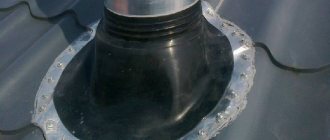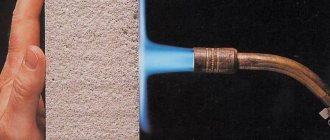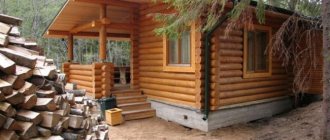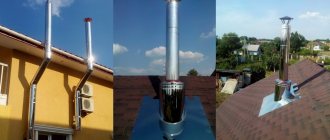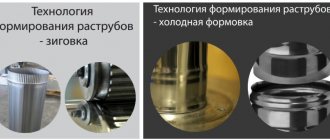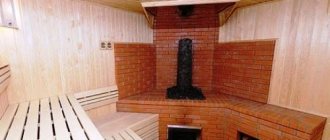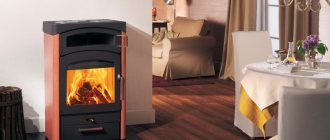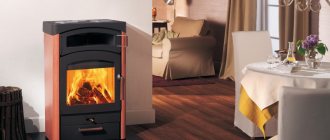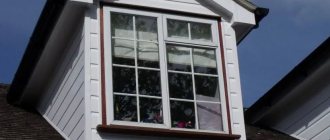A house with fireplace heating must have a well-sealed chimney.
Neglecting waterproofing leads to:
- Damage to the chimney. Brick chimneys quickly absorb moisture, which leads to splitting. Water penetrates into the smallest pores and expands when frozen. Ceramics or silicate are not ductile and cannot accommodate internal expansion.
- Increased pressure. Accumulated condensate leads to increased pressure, which reduces the draft and performance of the fireplace.
Waterproofing roof pipes does not require specialist intervention. You can do this yourself, as it is enough to follow a few tips. If you are not afraid of working at heights, it is better to buy the material and tools yourself. It will cost less compared to calling installers.
You will be faced with the question - “how to wrap the chimney pipe to prevent fire and leakage?” Below are the main materials and technologies for laying insulation, which can be found in a store or on the construction market.
Where does waterproofing begin?
The fireplace heating system will operate normally only if the work was carried out in accordance with the requirements of sanitary standards and regulations. At the state level, rules and recommendations for builders are regulated. By listening to them, you will be able to carry out insulation work without an emergency.
- Rafters and roofs should not be adjacent to each other. The spacing distance depends on the specific material. Combustible isolates should be spaced at least 150 millimeters to 300. Non-combustible (like asbestos and mineral wool) can be spaced between 100 and 250 mm. Be careful with flammables. Some gaskets are easily flammable. When combined with Euro slate, a fire may start, which will be difficult to extinguish.
- It is important to maintain the correct sequence of layers. Moisture should not be able to get inside the layer system, as it will destroy them. In addition, it will begin to accumulate and cause damage to the brick. There must be a mandatory gap between the pipe and the inner layer. Most isolates are flammable even at low temperatures.
- Don't neglect the box. This is the area that is between the roof and the insulation. It must be filled with any non-flammable material, such as mineral wool.
Insulating films should be cut to fit an envelope.
After this, they are pulled to the central beam so that it can be secured with hardware. Waterproofing is mounted on the sheathing, vapor barrier systems are installed on the frames. The joints between the box and the insulation are laid with special tapes.
How is it carried out?
Often after insulation work, the owner of the house notices sudden leaks. For example, they may be in the place where the roof meets the chimney pipe. The reasons for this are natural and always indicate an error.
An error occurred during one of the stages. To avoid leakage, you can install an apron.
When working, you must follow the following sequence:
- Moisture will form in any case - that’s why the insulating layer is needed. This can be avoided by using a drainage chute. This is a long groove into which water flows and is gradually removed to a safe place.
- Waterproofing pipes will be more productive if you install an apron inside to protect against leakage inside.
- A special backing can be cut from the waterproofing to cover the lower edge of the apron. For sheet roofs (profile decking, metal tiles, bitumen slate) it can be brought out between the sheets from below. To drain water, install a side that will direct the flow to the drain from the roof.
- There must be a roof covering around the pipe.
- You can make an apron yourself using ready-made drawings. Factory models are sold in fireplace stores. The pipe must pass inside it.
This instruction also works for exterior splashbacks.
Waterproofing tasks
Waterproofing pipes is the last stage in roofing work. If you ordered work from a team, you should know about laziness. Often developers and roofers neglect this stage because they consider them unnecessary. Indeed, for some time you can use fireplace heating without insulation, but after two winters you will feel a significant decrease in efficiency.
The procedure solves the following problems in the house:
- Increased security. New types of houses always have wood in their construction. For example, the roof sheathing is made of timber, which is a fire hazard. The heat released from the fire also goes into the chimney and can reach several hundred degrees. Solid fuel stoves are capable of developing a temperature that will cause the sheathing to smolder. The isolate will cut the wood and prevent it from igniting.
- Reduced heat loss. Due to the low temperature outside the window, the quality of the brick - thermal conductivity - comes into force. That is, it tries to equalize the temperature and cools the room.
- Condensation protection. Condensation, like moisture in general, is the main enemy of brick. As it accumulates and freezes (the effect of thermal conductivity), it expands by ten percent, which leads to damage to the ceramic structure. It begins to crumble and crumble, becomes loose and after a few years the chimney falls apart.
The waterproofing procedure dramatically increases comfort, as both the efficiency of the fireplace and the appearance of the roof are improved. Interior designers and experienced builders emphasize that properly done insulation makes a home look complete.
Any roofing material can be equipped with a nice apron, which is selected individually by color.
Consequences of an unsealed joint
To bring the chimney through the roof, a larger diameter is cut out into it, so that a gap remains between the walls of the chimney and the roofing material. Regardless of the width of the gap, it is a big problem faced by homeowners and builders. To eliminate this defect and protect the under-roof space from the penetration of atmospheric moisture, use seals, aprons, collars, made by yourself or purchased. An unsealed gap between the roof and the chimney pipe is fraught with the following consequences:
- Increased wear of roofing material. Most roof waterproofing materials offer better protection against moisture penetration from the outside. Moisture penetrating through an unsealed gap gets onto the inner surface of the roof and eventually destroys it.
- Reducing the service life of the rafter frame. The pouring water hits the elements of the rafter frame, which are made of wood. This leads to rotting and premature destruction of the rafters.
- Reduced insulation efficiency. Roof insulation materials lose their properties when wet, becoming less effective.
- Increased humidity in the attic. Increased dampness in the attic causes heavy, stale air and negatively affects the interior decoration of the room.
Clearance to prevent rafters from catching fire from a heated pipe
Important! The method of sealing the gap between the chimney and the roof depends on its size, the type of roofing material used and the shape of the chimney. If the distance is less than 5 mm, it is quite possible to get by with a heat-resistant silicone-based sealant. You can close a gap whose width is 1 cm or more using cement mortar, an apron, or a special sealant.
Materials used
There are many materials for waterproofing pipes in stores, but three types are traditionally used.
cotton wool
Common types of mineral wool are stone wool or glass wool. Sold in the form of rolls or slabs of different widths and thicknesses. Cotton isolates have:
- Soundproofing. The uneven structure, which is a set of dead-end corridors, absorbs sound well, preventing it from escaping. They are used indoors for sound recording, in homes and for roof insulation. Relevant if the roof is made of sheet material. By covering the passage of the pipe through the roof with corrugated sheets, you can significantly reduce the noise of rain.
- Low material density.
- Tight adhesion to surfaces. This is especially true if the roof has a shaped profile and denser materials are not able to provide a fit.
- Low heat capacity. The layer will not allow the brick to conduct heat, so the temperature in the room will not drop.
- Resistance to mechanical damage. It does not deteriorate with impacts, constant vibrations, or even intentional piercing influences. If a tear occurs, simply press the two parts together. The finest fibers will intertwine and become one.
- Electrical insulation. If there is electrical wiring under the roof, you don’t have to worry about short circuits.
- Chemical neutrality. Acids, resins, and adhesives will not be able to melt or decompose the cotton wool.
Roll filters
A mullite-siliceous mixture that impregnates the fibers. The filter is sold in rolls and has the following advantages:
- Flexibility. Can be bent at any angle. The consistency resembles cotton wool. Pliable and comfortable, does not require heating or cutting for bending. Easily installed on curved roofs.
- Any adhesives. Many isolates are sensitive to adhesives. Many require only organic adhesives, but the filter attaches well to inorganic ones. Does not dissolve and does not stick together.
- Easy to cut. To make cutting, scissors or a stationery knife are enough. Can be cut with a construction cutter.
- Fixed tightly.
Asbestos and kaolin boards
The composition is similar to previous materials. Recently, asbestos is rarely used due to its high carcinogenicity. That is, constant inhalation of its dust can lead to cancer. But, in the case of waterproofing a pipe on the roof, it will not be able to get into the air and harm health.
- Noise suppression. Copes with structural and spatial sounds, which is important if the pipes on the roof are made of metal tiles.
- Low thermal conductivity. Asbestos and kaolin are good thermal insulators that can be used in any type of home. It will keep the brick from freezing, which extends its service life.
- Resistance to mechanical and chemical influences. The only things that asbestos is susceptible to are alkalis and acids. Mechanically (shocks and vibrations) cannot damage it.
- Electrical insulation. The insulating properties of asbestos will remain up to temperatures of 800 degrees Celsius.
Metal apron
Brick pipes passing through the roof have expanded masonry ( fluffing ) and ledges ( overlap ), which serve as a heat and moisture insulator. Insulation of a brick chimney from moisture is done using a steel, lead apron, which is placed on the roof trim. First, the space in front of the pipe is covered with a layer of roofing felt with the edge raised to the wall. Corrugated sheeting or tiles are laid.
A steel apron is attached to special grooves on top. Then all joints are filled with sealant. Sometimes the chimney apron is part of an insulating steel wall, which is necessary in some cases (when condensation forms, when insulating walls). At the same time, the steel sheet in the lower part is bent to match the slope of the roof (corrugated sheeting) and has no joints, which increases the level of reliability against leakage. Metal aprons are also placed on round pipes if the temperature of the combustion products at the outlet is over 100 degrees.
Possible ways to eliminate gaps
Even a small gap can completely eliminate the usefulness of the waterproofing. If they are detected or reinsured, they can be eliminated. There are three ways to do this.
- Apron. You can buy ready-made ones in fireplace stores or make them yourself. For inexperienced DIYers, a store-bought one is better. The sizes are standardized, but require preliminary measurements.
- The roof penetration for chimneys can be steel. In this case, leaks are eliminated thanks to a clamp that physically prevents water from getting inside. This simplifies and facilitates the work.
- If the gap is small, it can be closed with silicone sealant. The sanitary type, designed for constant exposure to moisture, is better suited. In some cases, you can use homemade PVA-based mixtures with classification D
Depending on the roofing material, the method of eliminating leaks also changes. Pipes on a metal roof can only be equipped with an apron.
Insulate yourself or call a professional
It is better to entrust the laying of a fireplace chimney, stove or installation and connection of a gas boiler to specialists.
Thermal insulation work itself is a completely feasible task for any owner. Before starting work, it is important to understand the essence of the physical processes leading to the destruction of the structure and choose the right insulation.
Sealing a square pipe on a slate roof
Slate is an inconvenient material to work with, as it has a pronounced waviness. In this regard, any sealing methods will not lead to success.
The only exception is the cement-sand apron, manufactured according to the following algorithm:
- All visible cracks must be covered with collar pads. They must be made of non-corrosive material. It is better to take stainless steel or aluminum, since they, in principle, do not react with water. If you want to save money, galvanizing is suitable. When working with it, it is important to prevent damage to the zinc coating. The slightest scratches will lead to rust and further rotting.
- Filling. Make the usual mixture. It should be the consistency of sour cream - convenient for pouring, but not liquid. The level of the apron should be higher than the roof. To make it convenient, you need to make a cylinder in advance. It can be made from cardboard.
- Water drainage. Tilt the ledge so that the water drains away smoothly.
Types of sealants
In order for the sealant to perform its protective properties for a long time, it must be heat-resistant and moisture-resistant, so you cannot buy ordinary silicone or bitumen materials for these purposes. To do this, purchase a special heat-resistant silicone material or thiokol heat-resistant composition, which has a temperature indicator of up to 1300C. Good fluidity and elastic properties allow the sealant to penetrate deeply into the most inaccessible cracks and seams, filling them.
Silicone sealant for high-temperature pipe surfaces is made with the addition of iron oxide and is available in two types: acidic or neutral. The first, when cured, forms aggressive acetic or ethanoic acid, which makes it unsuitable for application to the surfaces of metals that are not resistant to corrosion, for example, low-alloy steel with weak anti-corrosion properties. In these cases, only neutral sealants are purchased, which harden with the release of alcohol and water. Typically, such insulators have a long warranty period of up to 20 years.
Silicate sealants can withstand a maximum temperature of about 1500 C. They, unlike elastic silicone compounds, create a durable solid layer after the hardening process is completed. Therefore, when structural units are displaced, cracks may form.
High-temperature pastes are available in standard colors:
- Red-brown, sometimes called automobile. Brown can withstand temperatures of 600 C, and red - up to 350 C.
- Black or furnace, operating in a temperature zone up to 1500 C with a brick flue.
The most important characteristic when choosing sealants according to GOST requirements is environmental safety; as a rule, the price of pastes will depend on this parameter.
Usually, cheap ones emit hazardous substances when heated. In the retail chain today, it is possible to purchase ready-made kits for waterproofing seams, which greatly simplifies the work.
Popular means for sealing chimney pipes:
- Iron aprons are the most common and are used for square chimneys. They are made in the form of a prefabricated device from a steel angle, attached to the roof slope and chimney.
- Rubber funnel-shaped seals for chimneys of round or oval cross-section. They are installed on the chimney using the tension method, fit it tightly and are fixed to the sheathing through the rolled covering.
- Membranes in the form of strips are glued around the circumference/perimeter of the pipe to protect against water ingress.
Sealing round multi-layer chimneys
Round chimneys are the most convenient to use. Their sealing occurs as follows.
- The edges of the pipe are primed with a special compound for metal.
- A hole is made in the waterproofing. After this, it is attached to the pipe using mastic. It is advisable to take bitumen. Despite the discomfort during operation, it does not bind to water and will not allow it to reach the pipe.
- The sheet is fixed on the roof sheathing. The pipe is passed through the prepared cap. There should already be a clamp and a temperature-resistant gasket inside.
If there is no cap, then any pipe seals will do.
Expert advice
Installation of thermal insulation of the boiler chimney must be carried out in compliance with installation norms and standards:
- the thermal insulation layer must be completely continuous, including in areas adjacent to the attic floor and roof elements;
- vapor barrier material is installed with the inscriptions facing out;
- the joining of sandwich pipe bends is carried out in such a way that the pipe of the lower bend fits inside the upper bend of the sandwich;
- external thermal insulation is carried out after the construction of the chimney, insulation from the inside is carried out during the process of its arrangement;
- if the roof is made of flammable building materials, then the chimney must be equipped with a spark arrester;
- All manipulations with mineral wool must be carried out using personal protective equipment to prevent particles from getting into the eyes and respiratory tract.
Sealing a pipe on a bitumen roof
Passing a chimney through a Euro slate roof is not an easy task. Its specificity is softness, so it will be quite difficult to use. The best way would be Wakaflex tape. This is an adjacent strip for sealing joints.
It is installed according to the following algorithm:
- The tape cutting is made in advance.
- It is pressed with the help of a case.
- Any gaps are removed using bitumen mastic.
Please note that bitumen roofs are best sealed during the cold season. Under the scorching sun it softens and becomes dangerous. If you move on the roof, there is a possibility of damaging the ondulin.
What are the main points you need to know when cutting?
- The distance between the roof and the rafters (25-30 cm) should be maintained for any roof covering. For flammable roofing materials (tar paper, wood, roofing felt) - 15-30 cm. For non-combustible roofing materials - 10-25 cm.
- What is difficult about the device is the option of passing the chimney through the “roofing pie”. “Roofing pie” is a complex roof structure that includes layers of vapor barrier, waterproofing and a layer of insulation. It is impossible to violate the integrity of the pie, as moisture can get inside and destroy the thermal insulation of the roof.
In addition, the insulating films inside the roofing pie are made of flammable materials. Therefore, a gap is required between the chimney and the roofing pie.
In this case, you need to make a separate box separating the pipe from the roof. The box is made from wooden rafters and a cross beam. The distance between the box and the chimney is 14-16 cm; it must be filled with non-flammable thermal insulation (for example, stone wool, which is not afraid of moisture).
The insulating films of the roofing pie in the exposed places are cut with an “envelope”, pulled up to the rafters and cross beams and secured with nails.
The waterproofing located in the cake is pressed with lathing, the vapor barrier is fixed with frames made for finishing. For absolute peace of mind, the joints of the insulating films and the box can be wrapped with special tapes.
Step-by-step insulation technology
Due to the fact that chimneys come in different types and designs, we will describe how to properly insulate a chimney pipe made of brick, asbestos cement and steel.
Chimneys made of asbestos cement
Asbestos cement pipe
To understand how to insulate a chimney from an asbestos pipe, we will analyze the entire procedure step by step, following the recommendations of professional builders:
First, you need to thoroughly clean the work area from dust and dirt; The next step is to make a special folding casing for the insulation (made from galvanized iron)
When determining its parameters, it should be taken into account that at least 6 cm should remain between the pipe and the iron for insulation; Pay attention to the fact that a casing assembled from several parts is put on the asbestos pipe, and each of them should not exceed 1.5 m; First of all, you should secure the lower part of the casing and carefully fill it with sealant. Then, the second part is put on and the procedure is repeated.
This design must run along the entire length of the asbestos pipe.
Thermal insulation diagram from a home craftsman
This is what an asbestos chimney with a casing looks like
Often, many cottage owners do without a casing. The pipe is simply wrapped in a roll of mineral wool and secured with staples. In order for this method of insulation to become truly reliable, several layers should be wound.
Steel chimneys
So, we seem to have sorted out the asbestos pipes, now let’s see how to insulate the metal chimney pipe. In general, many manufacturers of building materials produce ready-made chimneys made of stainless steel. The design is quite simple and consists of only two pipes of different diameters.
How to insulate a metal chimney? To do this, take a pipe of smaller diameter and insert it into a pipe of larger diameter. Then, the remaining space between the pipes is filled with any of the above types of insulation. If you are interested in modern materials, then we can recommend basalt chimney insulation, which in its structure resembles mineral wool, but is much more practical and durable.
Thermal insulation of a steel chimney
In principle, it is much easier to insulate an iron pipe than an asbestos pipe, so there should be no problems here.
Brick chimney
Brick chimney
Insulating a brick chimney is perhaps the most complex type of all presented in this article. Now we will present several options, from which everyone will choose for themselves how to insulate a brick chimney:
Plastering method. To do this, you will need to attach a reinforced mesh to the chimney. Then prepare a solution of lime, slag and a small portion of cement. Spread the resulting solution over the entire surface of the chimney and level it (all work is done in one layer, which should be at least 3 cm).
When the solution dries, you can add a few more layers and immediately cover up the resulting cracks. To give an attractive appearance, the pipe can be whitewashed or painted in the future.
Thermal insulation diagram of a brick chimney
Insulation with mineral wool. To do this, you will need to take a roll of basalt wool and cut it into pieces that correspond to the dimensions of the chimney area. Then, the insulation is glued to the pipe using tape. The last step of the work is to lay insulation (for example, Rocklight) with a second layer of bricks or asbestos-cement slabs.
The process of thermal insulation of a chimney with mineral wool
Good luck!
Types of insulation of chimney structures
The furnace pipe should be insulated against negative factors:
- from possible overheating of the chimney structure;
- from leaks that occur at joints.
Therefore, when deciding how to wrap a chimney pipe, increased attention should be paid to fire-proof thermal insulation and waterproofing. Experts recommend performing isolation measures comprehensively. This will help solve not only the above problems, but also improve the operating conditions of the furnace unit.
For example, if a chimney laid through an unheated attic is thermally insulated, the possibility of overheating of wooden roofing elements is reduced and the risk of condensation, which leads to corrosion, increased soot deposition or pipe destruction, is reduced. The main thing is that high-quality thermal insulation for chimney pipes should be used, which does not ignite. Waterproofing the smoke exhaust structure will protect the rafter system and ceilings from rotting.
